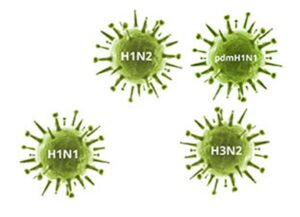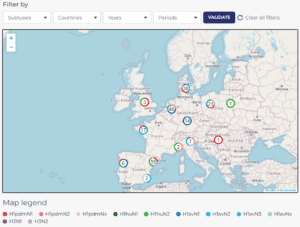Swine Influenza
INFLUENZA A VIRUS INFECTION IN SWINE
Swine influenza is a highly contagious viral disease of the respiratory tract in swine and is distributed globally.

H1N1, H3N2 and H1N2 are the most common influenza subtypes in swine, of which avian-like H1N1 is most frequent. All subtypes are continuously circulating in Europe. Since 2009 a new subtype, pdmH1N1 (2009), emerged globally and also entered in European pig population. Frequency of the different subtypes varies from country to country (further information on frequencies can be found here).
Surveillance programs are important to improve our knowledge about the dynamics of existing and future subtypes of swine influenza viruses. This will help to understand better the impact on swine production.
Why are influenza A virus infections so important?
Influenza A virus infections can have a huge impact as after infection animals may experience an extended period of reduced vitality, reduced daily weight gain, impaired reproductive performance and reduced disease resistance. Moreover an influenza disease can lead to secondary bacterial and viral infections which are responsible for complications in the course of an influenza infection. Depending on the severity of the outcome this can cause huge economic damage.
PROTECTING AGAINST INFLUENZA – PROTECTING YOUR FARM
Classical Influenza strains are widely established, pandemic Influenza is on the rise
Ceva offers diagnostic support to determine the swIAV situation in the field by providing technical support and intensive cooperation with veterinarians and leading scientists.
The results of this frequent passive surveillance is shown in the dynamic swine flu map.
In 2020 a high incidence of IAV-infections in about one quarter of the pigs were detected in a season-independent manner, by Henritzi et al. (https://doi.org/10.1016/j.chom.2020.07.006). More than half of the participating farms were affected. Findings included all four swine influenza A virus (swIAV) lineages and various genotypes. Increased detection of pandemic H1N1/2009, its reassortants and co-infections with different H1-subtypes were repeatedly documented.”
ONE HEALTH
The central idea of One Health approach is that health of humans and animals are closely linked and form a unity (further information on One Health can be found here).
According to a definition of the World Health Organization (WHO) “One Health” is an approach to designing and implementing programs, policies, legislation and research in which multiple sectors communicate and work together to achieve better public health outcomes.
The areas of work in which One Health is particularly relevant include food safety, the control of zoonoses (diseases that can spread between animals and humans, such as flu, rabies and Rift Valley Fever), and combatting antimicrobial resistance (when bacteria change after being exposed to antimicrobials and become more difficult to treat)
Many infectious diseases has zoonotic potential. Viruses such as pdmH1N1 (2009) reveal a potential cross-species transmission, either from humans to animals or vice versa from animals to humans.
In particular swine are thought to act as “mixing vessels”, meaning that pigs are next to swIAV susceptible to avian and human influenza viruses carrying both receptors in its lungs. As a result, there is a risk of novel influenza viruses being generated in pigs. This process is called reassortment which may lead to a new subtype that might be either more virulent, unfit for survival or might even show pandemic potential. Ultimately, there is a likelihood of transmission of these new reassorted viruses to humans.
Vaccination is one part of the One Health Strategy against swine influenza infection to reduce the emergence of new subtypes.
